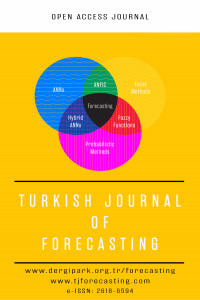Probabilistic Approach to the Future Course of Fiscal Stability in Turkey: 1958 – 2025
Probabilistic Approach to the Future Course of Fiscal Stability in Turkey: 1958 – 2025
fan chart, public debt forecast,
___
- [1] Berti K, (2013), “Stochastic Public Debt Projections Using The Historical Variance-Covariance Matrix Approach for EU Countries” European Comission Economic Papers Series, 480.
- [2]Blanchard, O., Chouraqui, J., Hagemann, R., Sartor, N. (1990). The Sustainability of Fiscal Policy: New Answers to An Old Question. OECD Economic Studies, 15, 8-36.
- [3]Burger, P., Stuart, I., Jooste, C., Cuevas, A. (2012). Fiscal Sustainability and The Fiscal Reaction Function for South Africa: Assesment of the Past and Future Policy. South African Journal of Economics, 80, 1-19.
- [4]Celasun, M., Rodrik, D. Turkish Experience with Debt: Macroeconomic Policy and Performance. In J. Sachs, Developing Country Debt and the World Economy (pp. 193-211). Chicago: University of Chicago Press. (1989).
- [5]Harvey, A.. Time Series Models. Cambridge: The MIT Press. (1993)
- [6]Hassine, H.. Financial Crises Management By The IMF : Was External And Public Debt Sustainable? Munich Personal RePEc Archive, MPRA Paper No. 75466,. (2015) pp: 1-20
- [7]Eichengreen, B., Gupta, P. (2016). Managing Sudden Stops. Washington: World Bank.
- [8]Ejaz, M. and Hyder, K, “A Fan Chart Approach to Debt Sustainability in Pakistan”, Lahore Journal of Economics 24:2, (2019),pp.1-23.
- [9]Grennes et al. “ Finding the Tipping Point-When Sovereign Debt Turns Bad”, World Bank Conference on Debt Management. (2010)
- [10]Krugman, P. Market-Based Debt-reduction Schemes. Washington: NBER(1989).
- [11]Melou et al. “An Application of the Fan-Chart Approach to Debt Sustainability in Post HIPC Low-Income Countries”, IMF Working Paper Series Volume 2014 Issue 102. (2014)
- [12]Reinhart, M,C. and Rogoff, K,S, “Growth in a Time of Debt” American Economic Review: Papers and Proceedings, 573–578. (2010)
- [13]Sachs, J., Huzinga, H. U.S. Commercial Banks and Developing Country Debt Crisis. Brookings Papers on Economic Activity, 18(2), (1987). pp. 555-606.
- Yayın Aralığı: Yılda 2 Sayı
- Başlangıç: 2017
- Yayıncı: Giresun Üniversitesi
Prasun BHATTACHARJEE, Rabin K. JANA, Somenath BHATTACHARYA
Orientation Determination in IMU Sensor with Complementary Filter
Muhammed Nazmi ÖZ, Serkan BUDAK, Ender KURNAZ, Akif DURDU
Kalman Filter and PID Application on Underwater Vehicles
Serkan BUDAK, Muhammet Halis TEKİN, Akif DURDU, Cemil SUNGUR
YOLOv5-based Vehicle Objects Detection Using UAV Images
Zeynep Nur DUMAN, Müzeyyen Büşra ÇULCU, Oğuzhan KATAR
Probabilistic Approach to the Future Course of Fiscal Stability in Turkey: 1958 – 2025
